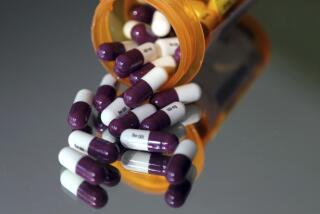Hopes Rise for Inexpensive AIDS Drug
- Share via
CHICAGO — Researchers in Los Angeles and Washington have identified what may be the first inexpensive AIDS drug, a finding that could have major importance for the 50% of HIV-positive Americans not receiving treatment because of its cost.
They also say that the drug, in conjunction with two other AIDS drugs, has induced what may be a permanent remission in three HIV-positive patients who have now gone for more than a year without treatment.
Although experts are skeptical about the remission claims, many are impressed by reported successes with the drug, called hydroxyurea, and have begun incorporating it into their own treatment regimens. The drug is unique in that it affects host cells in the patient rather than the virus.
“I think it is going to become a pretty permanent fixture” in AIDS therapy, said Dr. Paul Volberding of UC San Francisco. “By itself, it is not an antiviral agent, but it seems to make other drugs work better.”
The researchers think the drug works so well because HIV cannot develop resistance to it. Moreover, they believe that hydroxyurea also lessens chances of HIV resistance to other AIDS drugs as well.
The drug is inexpensive--no more than $30 per month, compared with the $1,300 monthly cost of the current gold standard for therapy, a chemical combination that includes the new class of AIDS drug called protease inhibitors, according to Dr. Jeffrey E. Galpin of the Sherman Oaks Hospital Research Institute, one of the researchers who has studied hydroxyurea.
It is not yet clear, though, whether hydroxyurea could replace existing anti-AIDS drugs or whether it would have to be used in combination with them.
The new drug looks promising, said Dr. Scott Hammer of Beth Israel Deaconess Medical Center in Boston, “but we need more data before it becomes more broadly used.”
Because it has been around so long, no company has exclusive rights to hydroxyurea. As a result, money for clinical trials has come from private donors.
Bristol Myers-Squibb, which sells hydroxyurea for cancer therapy under the brand name Hydrea, has agreed to sponsor a new trial in combination with ddI, another AIDS drug that the company sells. That trial will begin later this year at eight to 10 U.S. centers, although they have not been chosen yet.
Hydroxyurea is a simple drug that has been used for more than two decades in the treatment of leukemia. Its use was also approved recently for treatment of sickle cell disease.
Researchers first noticed its beneficial effects while treating leukemia patients who were HIV-positive, according to Galpin.
Dr. Franco Lori, who was then at the National Institutes of Health, studied hydroxyurea in the laboratory and concluded that it seemed to enhance the effects of ddI, also known as didanosine.
Didanosine is one of a class of drugs called reverse transcriptase inhibitors. Such drugs block an enzyme that HIV uses to reproduce its genetic material in host cells. The drugs tend to lose their effectiveness within a few months, however, because HIV mutates rapidly and develops resistance to them.
Hydroxyurea acts on the same cells to suppress the formation of the chemical building blocks that reverse transcriptase uses in its nefarious activity. The virus thus suffers a double whammy--its key reproductive enzyme is blocked directly and indirectly.
Lori left NIH and founded the Research Institute for Genetic and Human Therapy, headquartered at Georgetown University and in Pavia, Italy. He and Galpin began studying the drug in humans.
Galpin reported here at the Fifth Conference on Retroviruses and Opportunistic Infections that a combination of hydroxyurea, ddI and another reverse transcriptase inhibitor called d4T reduced the level of HIV in the blood of 42 patients below detectable levels. Freed from the impact of the viruses, the patients’ immune systems began to recuperate.
Lori and colleague Dr. Julianna Lisziewicz presented similar results Thursday in 42 HIV-positive patients treated with the three-drug combination. They also found successful suppression of the virus in 24 newly infected patients who were treated with hydroxyurea, ddI and a protease inhibitor called indinavir.
Significantly, they observed no development of resistance to ddI or d4T. “Hydroxyurea may, in fact, turn out to be a ‘sheltering’ drug in that it protects other drugs so that resistant mutations do not occur as rapidly,” Galpin said. “As a result, combination regimens can be administered for longer periods and to greater effect.”
And because hydroxyurea affects cells rather than the virus, HIV cannot develop resistance to its effects, Lori added.
One of Lori’s collaborators, Dr. Heiko Jessen of Berlin, also talked about a patient who had high levels of the virus in his blood when he began treatment with hydroxyurea, ddI and indinavir. At Christmas 1996, after seven months of treatment, the patient refused further therapy. Remarkably, the level of virus in his blood has remained below detectable levels ever since, even though there is evidence of the virus in his lymph nodes.
Dr. Jorge Vila and his colleagues at Aguettant-Fabre Virologie in Lyon, France, used hydroxyurea and ddI for 12 months to treat two men who had low but detectable levels of HIV in their blood. Two years after the end of treatment, neither man has had a rebound of virus levels. Critics, however, charge that the men may not have been infected in the first place.
“Those are interesting stories,” said Dr. Roy Gulick of Cornell University Medical Center. “If [the extended remissions are] true, we need to find out why it’s true.”
Lori noted that skeptics had put him through “purgatory” when he began testing the drug. “Finally,” he added, “I can talk at meetings without people shaking their heads.”






